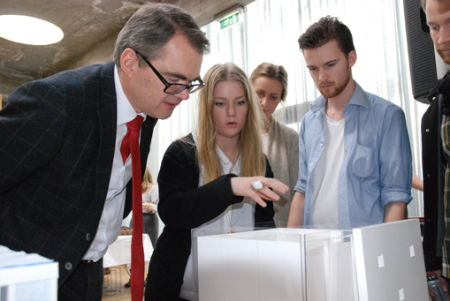At the Oslo School of Architecture and Design (AHO), the architectural students met Svein Richard Brandtzæg, CEO of Hydro. He stated that the company is delighted to see numerous talented students, working to find solutions for one of the main challenges in climatic change, energy waste in buildings. He also said that these students are the future architects.
 IMPRESSED: Architect students present their projects to Svein Richard Brandtzæg. From left, Svein Richard Brandtzæg, Jenny Rognli, Frida Johansen and Magnus Kvalheim.
IMPRESSED: Architect students present their projects to Svein Richard Brandtzæg. From left, Svein Richard Brandtzæg, Jenny Rognli, Frida Johansen and Magnus Kvalheim.
A workshop was conducted for second year students with focus on development of façade solutions for energy-saving solutions. A physical model of the solutions designed were displayed by these students, after working for three days.
Brandtzæg commented the architectural students have designed new creative and interesting solutions. It is amazing that these students have met the challenges of grasping new know-how and creating realistic solutions in a short period of time, he added.
Students Magnus Kvalheim and Jenny Rognli expressed delight in the fact that AHO has worked closely with Hydro and these students feel the importance of acquiring knowledge about the applications of aluminium and façades.
The group formed by Kvalheim and Rognli focused on the façade model for aluminium.
Kvalheim has stated that aluminium is a cool material to work on, due to its encouraging qualities. Aluminium is a lightweight material, but it is strong and malleable. Aluminium can actually transfer heat well, as the heat is easily absorbed and released. He added that aluminium is a highly recyclable metal. It is eco-friendly and energy-efficient and the recycled aluminium can save energy up to 95% that is needed to make new metal.
Currently around 40% of world’s total energy is used for buildings. Therefore, the future buildings have to be energy-efficient. Façades and aluminium can mainly contribute in the formation of elements, which can generate and save energy.
Source: http://www.hydro.com/